remove seats AUDI A3 2011 Owner´s Manual
[x] Cancel search | Manufacturer: AUDI, Model Year: 2011, Model line: A3, Model: AUDI A3 2011Pages: 320, PDF Size: 75.79 MB
Page 78 of 320
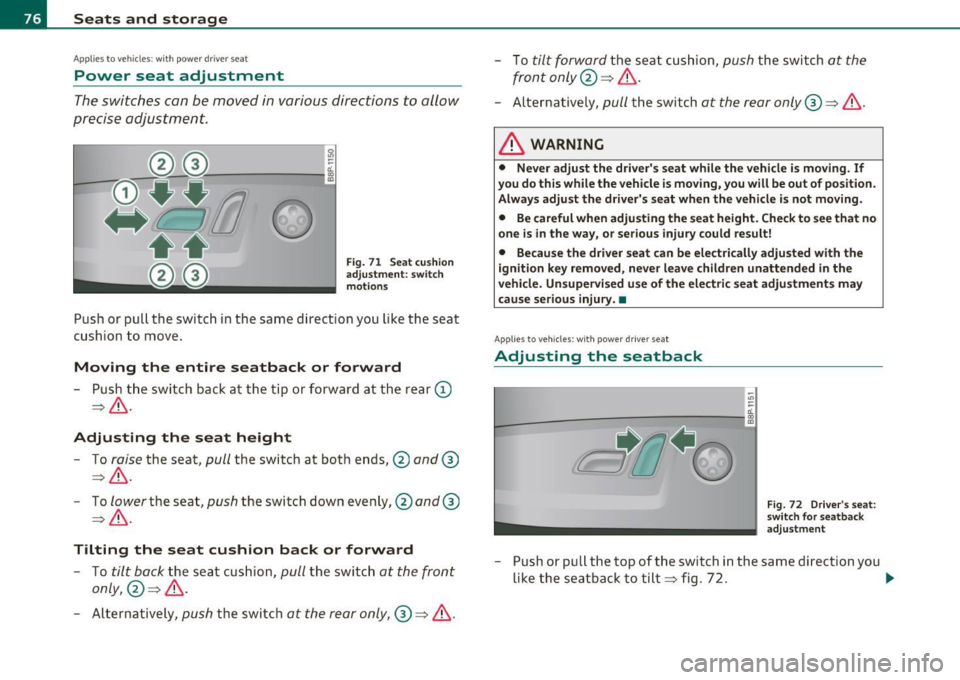
Seats and storage
Applies to veh icles : w ith power driver seat
Power seat adjustment
The switches can be moved in various directions to allow
precise adjustment.
Fig. 71 Seat cushion
adjustment: switch
motions
Push or pull the switch in the same direction you like the seat
cushion to move.
Moving the entire seatback or forward
- Push the switch back at the tip or forward at the rear (D
=>& .
Adjusting the seat height
- To raise the seat, pull the switch at both ends,@ and®
=>& .
- To
lower the seat, push the switch down evenly,@and @
=>& .
Tilting the seat cushion back or forward
- To tilt bock the seat cushion, pull the switch at the front
only, @=>& .
- Alternatively, push the switch at the rear only,®=>& .
-To tilt forward the seat cushion, push the switch at the
front only@=>& .
-Alternatively, pull the switch at the rear only®=>& .
& WARNING
• Never adjust the driver's seat while the vehicle is moving. If
you do this while the vehicle is moving, you will be out of position .
Always adjust the driver's seat when the vehicle is not moving.
• Be careful when adjusting the seat height. Check to see that no
one is in the way, or serious injury could result!
• Because the driver seat can be electrically adjusted with the
ignition key removed, never leave children unattended in the
vehicle. Unsupervised use of the electric seat adjustments may
cause serious injury. •
Applies to vehicles: with power driver sea t
Adjusting the seatback
Fig. 72 Driver 's seat:
switch for seatback
adjustment
- Push or pull the top of the switch in the same direction you
like the seatback to tilt=> fig. 72. _,,,
Page 81 of 320

Adjusting the head restraints
-To move the head restraint up, hold it at the sides with
both hands and slide it upward until you feel it click into
place.
- To move the head restraint down, press the button@
=>
page 78, fig . 75 and slide the head restraint downward.
Removing the head restraints2>
- Fold the backrest forward=> page 81.
-Move the head restraint upward as far as it can go.
- Press the release@=>
page 78, fig. 76 with the screw-
driver=>
page 2 70 and the button@=> page 78, fig. 75.
Pull the head restraint out of the backrest at the same
time=> &.
Installing the head restraints
Slide the posts on the head restraint down into the guides
until you feel the posts click into place.
- Press the button@=>
page 78, fig. 75 and slide the head
restraint all the way down. You should not be able to pull
the head restraint out of the backrest.
So that the driver can have a better view to the rear, the head
restraints should be pushed down completely when the rear seats are
not occupied.
& WARNING
• Only remove the rear seat head restraints when necessary in
order to install a child seat. Install the head restraint again imme-
2 l The head restraints cannot be removed from rear seats with fixed backrests.
Control s and equ ip
m ent Vehicle
OP-eration
Seats and storage
& WARNING (continued)
diately once the child seat is removed. Driving without head
restraints or with head restraints that are not properly adjusted
increases the risk of serious or fatal neck injury dramatically.
• Read and heed all WARNINGS~
page 128.
[I) Tips
Correctly adjusted head restraints and safety belts are an extremely
effective combination of safety features. •
Center armrest
The front center armrest can be adjusted to several posi
tions and contains a storage bin.
Adjusting the armrest
- Push the armrest down .
Fig. 77 Between the
front seats: armrest
folded down
-Lift the armrest slowly until it is in a comfortable position.
Opening the storage bin
- Pull the release button =>fig. 77 upward.
Vehicle care Do-it-yourselt service iTechnical data
Page 87 of 320
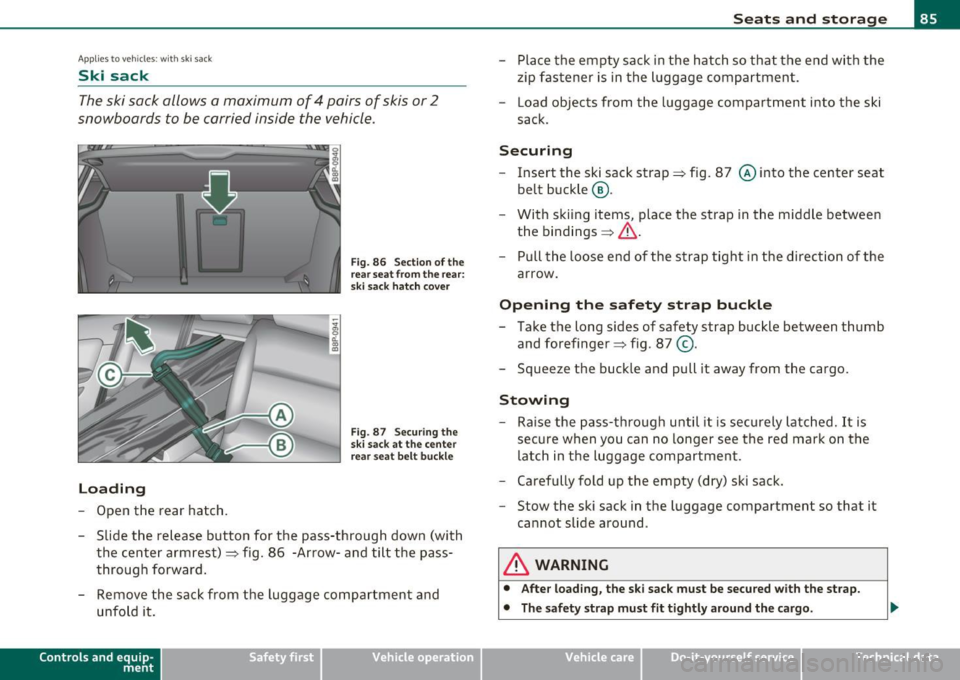
Applies to veh icles : w ith ski sac k
Ski sack
The ski sack allows a maximum of 4 pairs of skis or 2
snowboards to be carried inside the vehicle.
L oading
Open the rear hatch.
Fig. 86 Sect ion of the
rear sea t from the rear:
ski sack hatch cove r
Fig. 87 Sec uring th e
ski sack at the center
r ear seat belt buc kle
- Slide the releas e button for the pass-through down (with
the center armrest)=> fig . 86 -Arrow -and tilt the pass
through forward .
- Remove the sack from the luggage compartment and
unfold it.
Con tro ls a nd e quip
m en t Vehicle
OP-eration
Seats and storage
-Place the empty sack in the hatch so that the end with the
zip fastener is in the luggage compartment.
- Load objects from the luggage compartment into the ski
sack.
Securing
- Insert the ski sack strap=> fig. 87 © into the center seat
belt buckle ®·
- With ski ing items, place the strap in the middle between
the bindings =>
&-
- Pull the loose end of the strap tight in the direction of the
arrow .
Opening the safety strap buckle
-Take the long sides of safety strap buckle between thumb
and forefinger => fig . 87
@ .
- Squeeze the buckle and pull it away from the cargo.
Stowing
- Raise the pass-through until it is securely latched. It is
secure when you can no longer see the red mark on the
latch in the luggage compartment.
- Carefully fold up the empty (dry) ski sack .
- Stow the ski sack in the luggage compartment so that it
cannot slide around .
& WARNING
• Aft er loa din g, th e sk i sac k m ust be se cu red wit h th e strap .
• The saf ety s trap must fi t tig htly a rou nd the c argo .
Vehicle care Do-it-yourselt service Technical data
Page 88 of 320
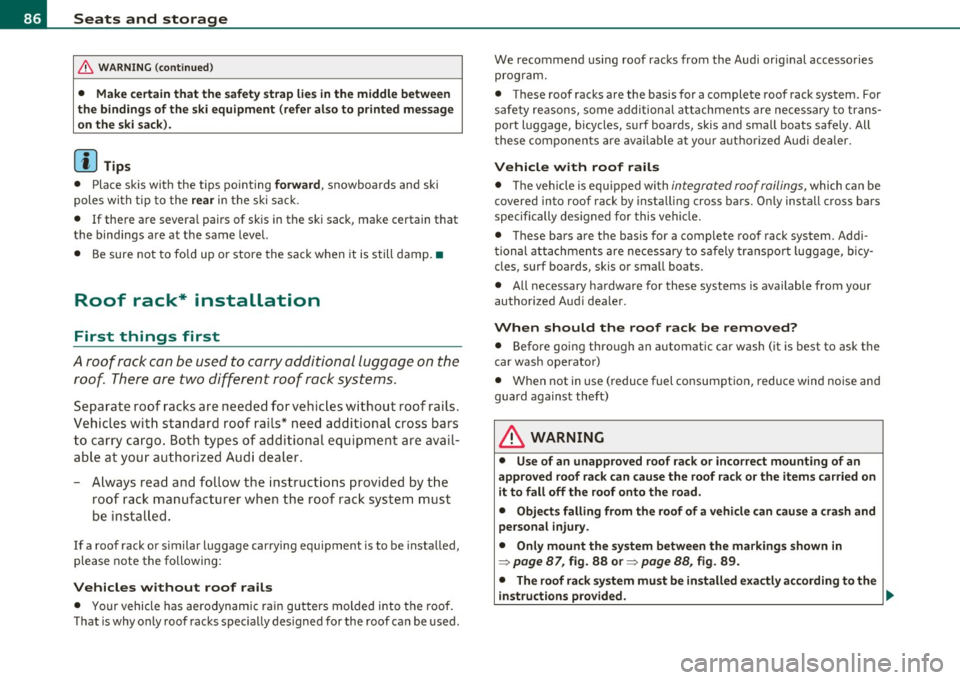
Seats and storage
& WARNING (continued)
• Make certain that the safety strap lies in the middle between
the bindings of the ski equipment (refer also to printed message
on the ski sack).
[ i J Tips
• Place skis with the tips pointing forward , snowboards and ski
poles with tip to the
rear in the ski sac k.
• If there are several pairs of skis in the ski sack, make certain that
the bindings are at the same level.
• Be sure not to fo ld up o r store the sack when it is still damp. •
Roof rack* installation
First things first
A roof rack can be used to carry additional luggage on the
roof There are two different roof rack systems.
Separate roof racks are needed for vehicles without roof rails.
Vehicles with standard roof rails* need additional cross bars
to carry cargo. Both types of additional equipment are avail
able at your authorized Audi dealer.
- Always read and follow th e instructions provided by the
roof rack manufacturer when the roof rack system must
be installed.
If a roof rack or similar luggage carrying equipment is to be installed,
please note the following:
Vehicles without roof rails
• Your vehicle has aerodynamic rain gutters molded into the roof.
Th at is why only roof racks specially designed for the roof can be used. We recommend using roof racks from the Audi orig
inal accessories
program.
• These roof racks are the basis for a complete roof rack system. For
safety reasons, some additional attachments are necessary to trans
port luggage, bicycles, surf boards, skis and small boats safely. All
these components are available at your author ized Audi dealer.
Vehicle with roof rails
• The vehicle is equ ipped with integrated roof railings, which can be
covered into roof rack by installing cross bars. Only install cross bars
specifically designed for this vehicle.
• These bars are the basis for a complete roof rack system. Addi
tional attachments are necessary to safely transport luggage, bicy
cles, surf boards, skis or small boats.
• All necessary hardware for these systems is available from your
authorized Audi dealer.
When should the roof rack be removed?
• Before going through an automatic car wash (it is best to ask the
car wash operator)
• When not in use (reduce fuel consumption, reduce wind noise and
guard against theft)
& WARNING
• Use of an unapproved roof rack or incorrect mounting of an
approved roof rack can cause the roof rack or the items carried on
it to fall off the roof onto the road .
• Objects falling from the roof of a vehicle can cause a crash and
personal injury.
• Only mount the system between the markings shown in
=> page 87, fig . 88 or=> page 88, fig . 89.
• The roof rack system must be installed exactly according to the
in structions provided . .,_
Page 91 of 320
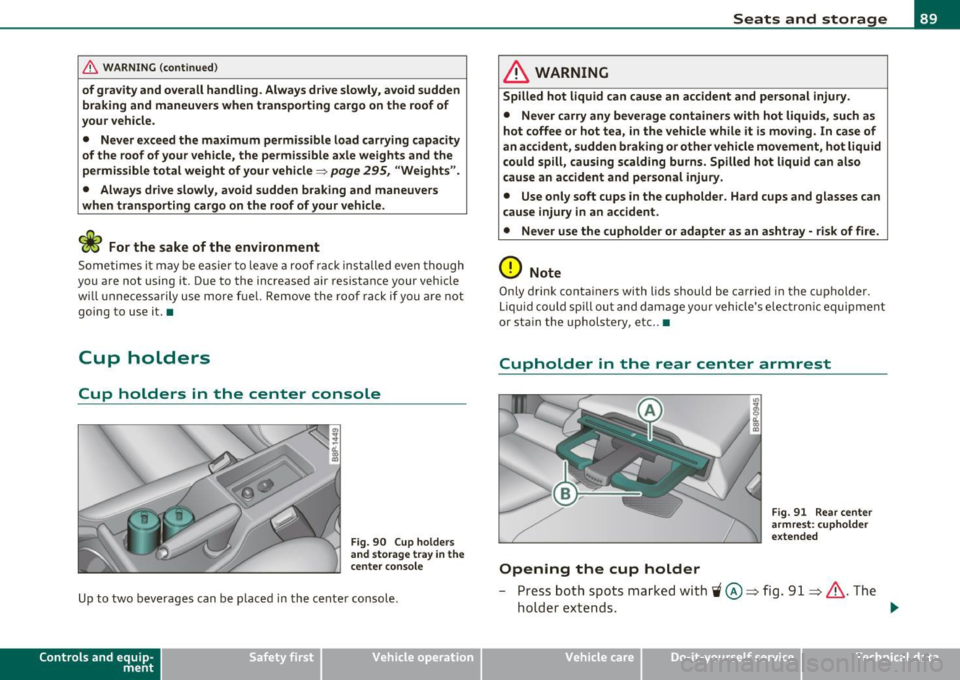
& WARNING (co ntinued )
of gra vity and o verall handling . Alwa ys dri ve slowly, avoid sudden
braking and maneuvers when tran sporting cargo on the roof of
your veh icle .
• Never exceed the maximum permi ssible load carrying capacity
of the roof of your vehicle, the permissible a xle weight s and the
permissible total weight of your vehicle ~
page 295 , "Weight s".
• Alwa ys d riv e slowly , avoid sudden b raking and maneuvers
when transporting carg o on the roof of your vehicle .
W For the sake of the environment
Sometimes i t may be easier to leave a roof ra ck i nstalled even tho ugh
you are not using it. Due to the increased air resistance your veh icle
wi ll u nne cessa rily use more f ue l. Remove the roof rack if you are not
going to use it. •
Cup holders
Cup holders in the center console
Fig. 90 Cup h older s
an d stor age tr ay in th e
c e nt er con sole
Up to two beve rages can be p laced in the cente r co nsole .
Cont rols a nd e quip
m en t Vehicle
OP-eration
Seats and storage
& WARNING
Spilled hot liquid can cause an accident and personal injury .
• Never carry any beverage container s with hot liquids, such a s
hot coffee or hot tea, in the vehicle while it is mov ing . In case of
an accident, sudden braking or other vehicle movement, hot liquid
could spill, causing scalding burns. Spilled hot liquid can also
c ause an accident and personal injury.
• Use only soft cups in the cupholder. H ard cups and glasses can
cause injury in an accident .
• Never use the cup holder or adapter as an ashtray· risk of fire.
0 Note
Only drink conta iners with lids should be carr ied in the c upholder.
L iq ui d could spill ou t an d damage your vehicle's e lec tron ic equipment
or sta in the upholstery, etc .. •
Cupholder in the rear center armrest
Opening the cup holder
Fig . 9 1 Rea r cente r
armrest : cu phol der
exten ded
- Press both spots ma rked with ii @ => fig. 91 => & -The
holde r ext en ds. .,_
Vehicle care Do-it-yourselt service iTechnical data
Page 93 of 320

- Plug in appliance to be used.
The outlet may be used for 12-volt app liances w ith maxim um
cons umption of up to 100 watts, such as a flash light, small vacuum
cl eaner, e tc.
Before you purchase any accessor ies, always read and fo llow the
info rm ation in::::,
page 301, "Add it io na l acc essories and p arts
re placemen t".
& WARNING
The outlet plus any appliances plugged into it remain functional
even if the ignition is switched off or the ignition key is removed. Never leave children inside the vehicle without supervision .
0 Note
To avoid damaging the socket, only use plugs that fit properly.
(I) Tips
When the engine is off and accessor ies are st ill plugged in and are on,
the ve hicle battery can sti ll be drained .•
Storage
General overview
There are numerous pl aces to st ore items in your vehi cle .
Storage in t he center armrest
Storage in the rear armrest
::::, page 79
Glove com partment (Ai r ven tila tion in t he ::::, page 92
glove compartment*, CD changer*)
Controls and equip ·
ment Safety first
Seats and storage
Center console ::::,
page 92
Compartments in the door tr ims ::::, page 93
Storage in the footwell ::::, page 93
Compartments in luggage compartment ::::, page 94
Coat hooks
Some of the storage locations are only fo und o n specific vehicle
mode ls o r are op tio nal equ ipme nt.
& WARNING
• Always remove objects from the instrument panel. Any items
not put away could slide around inside the vehicle while dri ving or
when accelerating or when applying the brakes or when dri ving
around a corner.
• When you are driv ing make sure that anything you may have
placed in the center console or other stor age locations cannot fall
out into the footwells. In c ase of sudden braking you would not be
able to b rake, depres s the clutch or accelerate .
• Any pieces of clothing that you have hung up must not inter
fere with the driver's view. The co at hooks are designed onl y for
lightweight clothing . Never hang any clothing with hard, pointed
or hea vy objects in the pockets on the coat hooks. During sudden
braking or in an accident· especially if the airbag is deployed ·
the se objects could injure any passengers inside the vehicle. •
Vehicle care Technical data
Page 142 of 320

___ s_ a_ f_ e_ t_ y~ b_ e_ lt_s _____________________________________________ _
- Insert t he tongue into the correct buck le of your seat until
you hear it latch secure ly==> fig. 131 .
- Pull on the be lt to make sure tha t it is secure ly la tched in
the buck le.
Automatic safety belt retractors
Every safety be lt is equipped with an automatic be lt retractor on the
shoulder be lt. This feat ure locks the be lt whe n the belt is pulled out
fast, during hard braking and in an acc ident. The belt may also lock
w hen you dr ive up or dow n a steep hill or throug h a sharp curve.
Dur ing normal driv ing the belt lets you move freely.
Safety belt pretensioners
The safety belts are equipped w ith a belt pretensioner that helps to
t ighten the safety be lt and remove sla ck when the p re tensioner is
act ivated. The function of the pretensioner is monitored by a warn ing
light =>
page 15.
Switchable locking feature
Every sa fety be lt ex ce pt t he one on the driver sea t is eq uipped wi th a
switchab le locking feature that
must be used when the safety belt is
used to at tach a child safety seat. Be s ure to read t he importa nt info r
mation about this feature=>
page 177.
& WARNING
Imp roperly positioned safety belts can c au se se rious injury in a n
accident =>
page 140, "Safety b elt po sition ".
• Safety belts offer optimum protection only when the seatback
i s upr ight and belts are properly positioned on the body .
• Always make sure th at the rear seat backre st to which the
center rear safety belt is attached i s secur ely latched when ever the
rear cente r sa fety belt is be ing u sed . If the ba ckre st is not securely
latched, the pas senger will move forward with th e backre st during
sudde n braking, in a sudden maneuve r and especiall y in a crash .
& WARNING (continued )
• Never attach the safety belt to the buckle fo r another seat .
Attaching the belt to the wrong buckle will reduce safety belt
effectiveness and can cause ser ious personal injury.
• A pass enger who i s not properly restrained can be seriou sly
i njured by the safety belt itself when it mo ves from the stronger
part s of the body into critical area s like the abdomen.
• Alway s loc k the convertible locking retractor when you a re
securing a child safety seat in the vehicle=>
page 179. •
Safety belt position
Correct belt position is the key to getting maximum
pro tection from safety belts .
Fig. 132 Hea d
r e str aint a nd safet y
belt po sit ion a s seen
from the side
Standard features on your vehicle help you adjust the position of the
safety belt to match your bo dy size.
• belt h eight adjustment for the fron t sea ts,
• automatic belt height adjustment for the rear seats .
Page 155 of 320
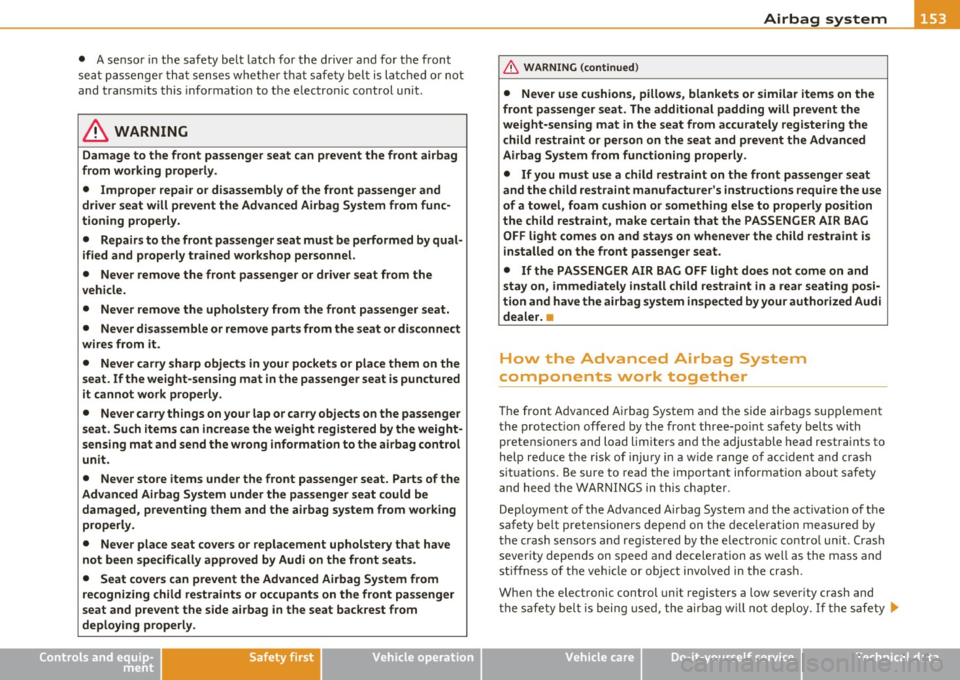
----------------------------------------------~A....::..:.... ir:....: b.::..:;; a..::g ~ s~y -=s:....: t:...: e:...: m...:....:.. __ _
• A se nsor in the safety belt latch for the d river a nd fo r th e front
sea t passenge r that senses w heth er that sa fe ty bel t is la tched or no t
and tra nsmits this information to t he e lectron ic co ntrol un it.
& WARNING
Damage to the front passenger seat can prevent the front airbag
from working properly.
• Imprope r repair or disassembly of the front passenger and
driver seat will prevent the Advan ced Airbag System from func
tioning properly.
• Repairs to the front passenger seat must be performed by qual
ified and properly trained workshop personnel.
• Never remove the front passenger or driver seat from the
vehicle.
• Never remove the upholstery from the front passenger seat.
• Never disassemble or remove parts from the seat or disconnect
wires from it .
• Never carry sharp objects in your pockets or place them on the
seat. If the weight-sensing mat in the passenger seat is punctured
it cannot work properly .
• Never carry th ings on your lap or carry objects on the passenger
seat . Such items can increase the weight regi stered by the weight
sensing mat and send the wrong information to the airbag control
unit.
• Never store items under the front passenger seat. Parts of the
Advanced Airbag System under the passenger seat could be damaged, preventing them and the airbag system from working
properly.
• Never place seat covers or replacement upholstery that have
not been specifically approved by Audi on the front seats .
• Seat covers can prevent the Advanced Airbag System from
recognizing child restraint s or occupants on the front passenger
seat and prevent the side airbag in the seat backrest from
deploying properly .
Controls and equip ment Safety first Vehicle operation
& WARNING
(co ntinued )
• Never use cushions , pillows, blankets or similar items on the
front passenger seat . The additional padding will prevent the
weight-sensing mat in the seat from accurately registering the
c hild restraint or person on the seat and prevent the Advanced
Airbag System from functioning prope rly.
• If you must use a child restraint on the front passenger seat
and the child restraint manufacturer's instructions require the use
of a towel, foam cushion or something else to properly pos ition
the child restraint, make certain that the PASSENGER AIR BAG
OFF light come s on and stays on whenever the child re straint is
installed on the front passenger seat.
• If the PASSENGER AIR BAG OFF light does not come on and
stay on, immediately install child restraint in a rear seating posi
tion and have the airbag system inspe cted by your authorized Audi
dealer. •
How the Advanced Airbag System
components work together
T he front Advanced A irbag System and the side airbags sup plement
t he p ro tect io n offered by the front three-po int safety belts w ith
pretens io ners and load limiters and t he adjustable head restra ints to
help red uce the risk of injury in a w ide range of acci den t and cras h
sit uat ions. Be sure to read the important informat ion about safety
and hee d the WAR NINGS in this ch ap ter.
Deployme nt of the Adva nced A irbag System and the act ivation of t he
safety belt pretens ione rs depen d on the dece le ration measure d by
the crash sensors a nd reg istered by the e lectro nic contro l un it . Crash
sever ity depends on speed and decele ration as well as the mass and
st iff ness of t he ve hicle or object invo lved in the cras h.
Whe n the electronic contro l unit registers a low sever ity crash and
t he safety be lt is being used , the air ba g w ill not dep loy . If the safety
~
Vehicle care Do-it-yourself service Technical data
Page 178 of 320

____ C_ h_ i _l_d _S_ a_f _e _ty ~ --------------------------------------------
- A lways make sure that the chi ld can properly wear the lap
po rtio n of the belt low across t he th ig hs o r pelvis a nd
never over the stomach o r abdome n.
Ch ild ren up t o at le ast 8 years old (over 40 lbs or 18 kg) are best
protected in child safety seats des igned for their age and we ight.
Expe rts say t hat the ske letal structure, par tic ul arly the pelvis, of
these ch ildren is not fully developed, a nd they must not use the
vehicle safety belts w it h out a suitable c hild rest raint.
It is usually best to pu t these ch ildren in app ropria te booster seats.
Be sure the booster seat meets all appl icable safety standards.
Booste r seats r aise the se ating posi tion of the child and reposi tion
both the lap and sho ulder parts of the safety belt so t hat they pass
across the c hild 's body i n the rig ht places . The ro uting of the be lt ove r
t he c hild 's body is ve ry i mp ort an t fo r th e ch ild's p rot ection, wh eth er
or not a booster seat is used . Children age 1 2 and under m ust a lways
r ide in t he re a r se at.
Chi ldren who are at least 4 ft . 9 in. (57 inc hes/1. 45 meters) tall can
gene rally use t he ve hicl e's th ree poi nt la p and sho uld er bel ts. N ever
use t he lap belt port ion of the vehicle 's safety belt alone to restra in
a ny chi ld , re gar dless o f how big t he ch ild i s. Always remem ber that
childr en do no t have the pronounced pelvic s tru ctur e required for the
pr op er f unc tion of lap belt port io n of the vehi cle's t hree poin t lap and
shoulder b elts. Th e chi ld's saf ety absolu tely r equir es tha t a lap belt
portion of the safety be lt be fastened snugly and as low as possible
arou nd the pelvis. Never l et t he lap bel t port ion of the safety b elt
pass over the child's stomach o r abdome n.
I n a cra sh, air bag s must inflat e withi n a bli nk of an eye a nd wi th
cons iderable fo rce. In o rder to do its job, the airbag needs room to
in flat e so t hat it will b e the re to p rotect th e occupa nt a s th e occu pan t
mov es forward into t he a irbag.
A vehi cle occ upant who is out of position and too close to the a irba g
ge ts in the w ay of an inf latin g air bag. Whe n an o ccup ant is too clos e,
he or s he will be struck violently and will rece ive s erio us or poss ibly
eve n fata l in jury. I
n order for the airbag to offe r protect ion, it is impo rta nt t hat all
ve hicle occupant s, especiall y any childr en , wh o must b e in t he front
sea t beca use of exc eptiona l circu mstances, be pro per ly r estra ined
and as far away from t he a irba g as possib le . By keep ing room
b etween t he child's body and the front o f the passenger co mpart
ment , th e a irba g can inflate completely an d prov ide sup plemental
pr ote ction in ce rt ain fro ntal coll isions.
& WARNING
Not using a booster seat, using the booster seat improperly, incor
rectly installing a booster seat or using the vehicle safety belt
improperly increases the risk of serious personal injury and death
in a collision or other emergency situation. To help reduce the risk
of seriou s personal injury and/or death:
• Always make sure to position the shoulder portion of the three
point belt over the middle of child 's shoulder.
• Never let the shoulder portion of the belt rest against or acros s
the neck, face, chin, or throat of the child.
• Always make sure the lap belt portion of the three-point belt is
worn snug and passes as low as possible across the child's pelvis.
Never let the belt pass over the soft abdomen.
• Failure to properly route safety belts over a child's body will
cause severe injuries in an accident or other emergency situation
~ page 135 .
• The rear side of the booster seat should be positioned as close
as possible to the backrest on the vehicle seat. Adjust or remove
the rear seat head restraint if it is difficult to install the child seat
with the head restraint in place
~ page 78 . Install the head
restraint again immediately once the child seat i s removed.
Driving without head restraints or with head restraints that are
not properly adjusted increases the risk of serious or fatal neck
injury dramatically.
• Children on the front seat of any car, even with Advanced
Airbags, can be seriously injured or even killed when an airbag
inflates.
Page 185 of 320

_____________________________________________ C _h_i_ld _ S_ a_ f_ e_ t ... Y'--- __
Installing a child restraint with LATCH
lower anchorages
Whenever you install a child restraint always follow the
child restraint manufacturer's instructions .
Mounting
Fig. 151 Lower
anchorages: proper
mounting
- Remove the cover* to access the lower anchorage attach
ment points.
- Make sure the seatback of the rear seat bench is in the
upright position and securely latched in place .
- Attach both hook-on connectors with the spring catch
release on the child safety seat onto the LATCH lower
anchorage so that the connectors lock into place
=> fig. 151.
-Pull on the connector attachments to make sure they are
properly attached to the LATCH lower anchorage.
- Pull straps tight following the child restraint manufac
ture r's instructions.
Controls and equip
ment Safety first Vehicle operation
Releasing
-
Loosen the tension on the straps following the child
restraint manufacturer's instructions.
- Depress the spring catches to release the anchorage hooks
from the lower anchorages .
Remember: Use tether straps to help keep the child restraint firmly
in place.
& WARNING
Improper use of the LATCH system can increase the risk of serious
personal injury and death in an accident.
• These anchors were developed only for child safety seats using
the "LATCH" system.
• Never attach other child safety seats, belts or other objects to
these anchors.
• Always make sure that you hear a click when latching the seat
in place. If you do not hear a click the seat is not secure and could
fly forward and hit the interior of the vehicle, or be ejected from
the vehicle.
& WARNING
Improper installation of child restraints will increase the risk of
injury in an accident.
• Always follow the child restraint system manufacturer's
instructions for proper installation of the child restraint system
and proper use of tether straps as well as the lower anchorages or
safety belts in your vehicle.
• Always read and heed the important information and WARN
INGS about child safety and the installation of child restraint
systems =>
page 167, "Child Safety". •
Vehicle care Do-it-yourself service Technical data